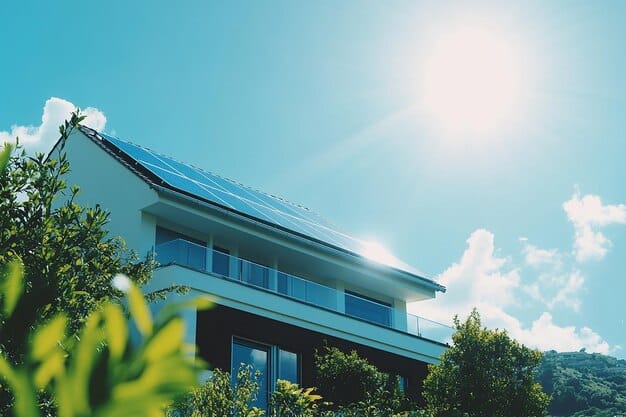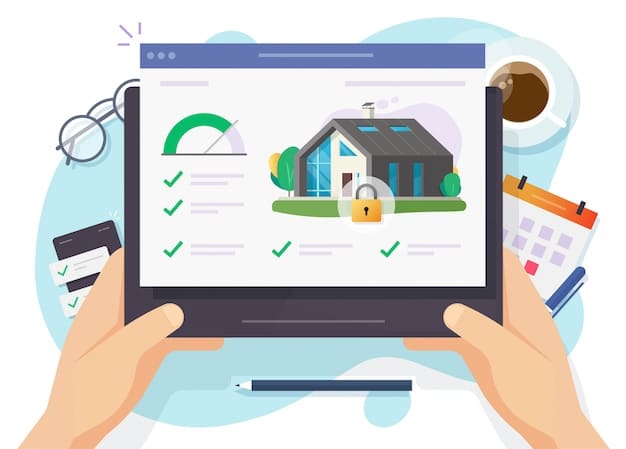Claiming Energy-Efficient Home Improvement Tax Credits in 2025

Maximize your savings in 2025 by claiming energy-efficient home improvement tax credits, a valuable opportunity for homeowners to reduce their tax burden while investing in eco-friendly upgrades that enhance their property’s efficiency.
Investing in energy-efficient home improvements not only benefits the environment but can also significantly reduce your tax liability. This guide provides a step-by-step approach to maximize your savings: A Step-by-Step Guide to Claiming Energy-Efficient Home Improvement Tax Credits in 2025.
Understanding Energy-Efficient Home Improvement Tax Credits
Energy-efficient home improvement tax credits are incentives offered by the government to encourage homeowners to invest in upgrades that reduce energy consumption. These credits can offset the cost of improvements while promoting environmental sustainability. Understanding the specifics of these credits is crucial for maximizing your potential savings.
What are Energy-Efficient Home Improvements?
Energy-efficient home improvements include upgrades that reduce energy consumption, such as installing solar panels, energy-efficient windows, and insulation. These improvements not only lower your utility bills but also qualify you for tax credits. The key is to ensure that the improvements meet the specific standards set by the IRS and the Department of Energy.
Types of Energy-Efficient Home Improvement Tax Credits
There are generally two primary tax credits available for energy-efficient home improvements: the Energy Efficiency Home Improvement Credit and the Residential Clean Energy Credit. The first covers improvements to the home itself, while the second focuses on renewable energy systems. Knowing the difference helps in planning your upgrades.

- Energy Efficiency Home Improvement Credit: This credit covers 30% of qualified expenses for improvements like energy-efficient windows, doors, insulation, and air conditioners.
- Residential Clean Energy Credit: This credit covers investments in renewable energy systems, such as solar panels, solar water heaters, and wind turbines.
- Specific Requirements: Each credit has specific requirements that must be met to qualify, including energy efficiency standards and installation guidelines.
Understanding the types of credits and their specific requirements is the first step in maximizing your tax savings. By making informed decisions about your home improvements, you can take full advantage of these incentives.
Step-by-Step Guide to Claiming Tax Credits
Claiming energy-efficient home improvement tax credits involves several steps, from planning your upgrades to filing your tax return. This step-by-step guide will walk you through the process, ensuring you don’t miss any key details.
Step 1: Research and Plan Your Home Improvements
Before starting any home improvement project, research the available tax credits and their requirements. Identify the upgrades that not only meet your needs but also qualify for the credits. Planning ahead ensures you make informed decisions and maximize your potential savings.
Step 2: Ensure products are certified
For equipment to qualify for the tax credit, it has to be certified. Consult manufacturer specifications and test reports to demonstrate that the equipment meets the relevant standards set by either the Department of Energy or the Environmental Protection Agency (EPA).
Step 3: Keep Detailed Records and Receipts
Maintaining detailed records and receipts is crucial for claiming the tax credits. Keep invoices, installation records, and any other documentation that proves the improvements were made and meet the required standards. These records will be essential when you file your tax return.

- Documentation: Keep all receipts and invoices related to your energy-efficient home improvements.
- Product Specifications: Save product specifications and certifications to prove that the improvements meet the required standards.
- Installation Records: Maintain records of the installation process, including dates and any relevant details about the installation.
By following these steps and maintaining thorough records, you can confidently claim the energy-efficient home improvement tax credits and maximize your financial benefits. Remember to consult with a tax professional for personalized advice and to ensure compliance with all applicable regulations.
Navigating IRS Forms and Requirements
The IRS has specific forms and requirements for claiming energy-efficient home improvement tax credits. Understanding these forms and following the requirements is essential for a successful claim. Familiarizing yourself with the relevant documentation can save time and prevent delays.
Which IRS Forms Do You Need?
To claim these tax credits, you’ll typically need IRS Form 5695, Residential Energy Credits. This form is used to calculate and claim the credits for qualified energy-efficient improvements and renewable energy systems. Make sure to download the latest version of the form from the IRS website.
Completing Form 5695: A Detailed Walkthrough
Form 5695 requires you to provide details about the qualified expenses you incurred for your energy-efficient home improvements. The form is divided into sections for different types of credits, such as the Energy Efficiency Home Improvement Credit and the Residential Clean Energy Credit.
Understanding the Credit Limits and Restrictions
The amount of credit you can claim is subject to certain limits and restrictions. For example, the Energy Efficiency Home Improvement Credit has annual limits on the amount you can claim for certain improvements. Understanding these limits is crucial for accurately calculating your credit.
Navigating IRS forms and requirements can be complex, but with careful preparation and attention to detail, you can successfully claim the energy-efficient home improvement tax credits. Consult with a tax professional for personalized guidance and to ensure compliance with all applicable regulations.
Common Mistakes to Avoid
Claiming energy-efficient home improvement tax credits can be tricky, and it’s easy to make mistakes that could jeopardize your claim. Being aware of these common pitfalls can help you avoid them and ensure a smooth process. Identifying and rectifying these mistakes early on is key.
Not Meeting the Energy Efficiency Standards
One of the most common mistakes is failing to meet the energy efficiency standards set by the IRS and the Department of Energy. Make sure the improvements you make meet these standards to qualify for the tax credits. Check product specifications and certifications to ensure compliance.
Incomplete or Missing Documentation
Incomplete or missing documentation can also lead to problems when claiming the tax credits. Keep detailed records of all expenses, invoices, and installation records related to your energy-efficient home improvements. Without proper documentation, your claim may be denied.
Misunderstanding the Credit Limits
Misunderstanding the credit limits and restrictions can result in an inaccurate claim. Each tax credit has specific limits on the amount you can claim, and exceeding these limits can lead to errors. Be sure to understand the rules and regulations before filing your tax return.
- Double-Check Specifications: Always verify that the improvements meet the energy efficiency standards.
- Keep Comprehensive Records: Maintain detailed records of all expenses and related documentation.
- Understand the Limits: Be aware of the credit limits and restrictions to avoid errors in your claim.
Avoiding these mistakes can significantly increase your chances of successfully claiming energy-efficient home improvement tax credits. By being diligent and paying attention to detail, you can maximize your savings and enjoy the benefits of your eco-friendly home upgrades.
The Future of Energy-Efficient Tax Credits: What to Expect in 2025
The landscape of energy-efficient tax credits is constantly evolving, and it’s essential to stay informed about potential changes. Knowing what to expect in 2025 can help you plan future home improvements and maximize your tax savings. Staying updated on legislative changes is critical for informed decision-making.
Potential Changes to Credit Amounts
Keep an eye on potential changes to the credit amounts for energy-efficient home improvements. These amounts can be adjusted based on legislative updates and government policies. Staying informed ensures you are aware of any increases or decreases in the available credits.
New Qualifying Improvements
The list of qualifying improvements for energy-efficient tax credits may expand to include new technologies and upgrades. Staying updated on these changes can help you identify additional opportunities to save on your taxes. Explore the latest innovations in energy efficiency.
Legislative Updates and Extensions
Legislative updates and extensions can impact the availability and duration of energy-efficient tax credits. Monitoring these changes can help you plan your home improvements strategically. Stay informed about any potential extensions or expirations of the credits.
Staying informed about the future of energy-efficient tax credits is essential for homeowners looking to maximize their savings. By monitoring potential changes and legislative updates, you can plan your home improvements strategically and take full advantage of these valuable incentives.
Consulting with Tax Professionals and Energy Auditors
Navigating the complexities of energy-efficient home improvement tax credits can be challenging. Consulting with tax professionals and energy auditors can provide valuable insights and ensure you’re making informed decisions. Seek expert advice to optimize your savings.
Benefits of Hiring a Tax Professional
A tax professional can provide personalized guidance on claiming energy-efficient home improvement tax credits. They can help you understand the specific requirements, navigate the IRS forms, and maximize your potential savings. Professional assistance ensures compliance and accuracy.
How Energy Auditors Can Help
Energy auditors can assess your home’s energy efficiency and recommend improvements that qualify for tax credits. They can also provide valuable insights into reducing your energy consumption and lowering your utility bills. An energy audit is a worthwhile investment for homeowners seeking to maximize their energy savings.
Finding Qualified Professionals
When seeking tax professionals and energy auditors, look for qualified and experienced individuals. Check their credentials, read reviews, and ask for referrals. Choosing the right professionals can make a significant difference in your ability to claim the tax credits and achieve your energy efficiency goals.
| Key Point | Brief Description |
|---|---|
| 💰 Tax Credits | Government incentives for energy-efficient upgrades. |
| 📝 IRS Forms | Required forms like Form 5695 for claiming credits. |
| ✅ Certification | Ensuring products meet standards set by the DOE or EPA. |
| 📈 Expert Advice | Consulting with professionals for personalized guidance. |
Frequently Asked Questions
▼
The Energy Efficiency Home Improvement Credit covers 30% of qualified expenses for improvements like energy-efficient windows, doors, insulation, and air conditioners. This helps homeowners save on taxes while making eco-friendly upgrades.
▼
The Residential Clean Energy Credit covers investments in renewable energy systems, such as solar panels, solar water heaters, and wind turbines. It encourages homeowners to invest in clean energy solutions.
▼
To claim these tax credits, you typically need IRS Form 5695, Residential Energy Credits. This form is used to calculate and claim credits for qualified energy-efficient improvements and renewable energy systems.
▼
Energy auditors can assess your home’s energy efficiency and recommend improvements that qualify for tax credits. They provide insights into reducing energy consumption and lowering utility bills, maximizing your savings.
▼
Common mistakes include not meeting energy efficiency standards, incomplete documentation, and misunderstanding credit limits. Avoiding these mistakes ensures a smooth and successful claim process for tax credits.
Conclusion
Claiming energy-efficient home improvement tax credits in 2025 is a strategic way to reduce your tax burden while investing in sustainable upgrades. By understanding the types of credits available, following the step-by-step guide, and avoiding common mistakes, you can maximize your savings and contribute to a greener future.





